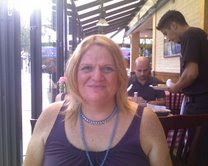- ...and an athlete...Andrew Clark
- ...and a basket case...Allison Reynolds
- ...a princess...Claire Standish
- ...and a criminal...John Bender
Does that answer your question?... Sincerely yours, the Breakfast Club.
Call me a sucker, but just for that letter, I'm willing to forgive, if not overlook, the omissions and other deficiencies of Hughes' work.
So why am I thinking about that letter, or The Breakfast Club, now? Well, as simplistic as the plot and the expressed point of view of that movie are, that letter--and the way the actors portrayed their characters--shows at least an awareness of the blind spots not only of the characters, but of those who created, played and directed them. That, I think, is more than can be said of anything Woody Allen ever did. And it's certainly shows more awareness than most writers, directors and others involved in film and TV show when it comes to the way they portray people of color, not to mention transgender or other gender-variant people.
"Transgender," "transsexual," and "transvestite" are among those "simplest terms" to which Brian Johnson alludes in his letter. At least, they are in pretty much every film and TV program I've seen that has a gender-variant character or in which gender variance is a theme or sub-theme. And, because they are the "simplest terms," they can only convey "the most convenient definitions."
And that is why David Reuben's Everything You Always Wanted to Know About Sex But Were Afraid to Ask and Woody Allen's eponymous movie were so wildly popular. If I recall correctly, Dr. Reuben's book spent a year or so on the Times best-seller list and the film was Allen's most commercially successful up to that point. (I suspect that people who liked it probably weren't fans of Annie Hall, much less Interiors.)
It's been decades since I read Dr. Reuben's book or saw Woody Allen's movie. But, as I recall them, they both reinforced the ideas most people had about transgendered people: that they were guys in dresses who had sex with prepubescent kids. (How ironic was it that Woody Allen was engaged in, uh, extracurricular activities with his stepdaughter?)
As near as I can tell, part of being "in the closet" means accepting, and even reenforcing those stereotypes that are presented as verities and accepted as archetypes. By that definition, I reckon, most of us have been in the closet at some point or another. Although I lived in a working-class Brooklyn neighborhood until I was thirteen, I rarely, if ever, saw an African-American, Latino or Asian person. And, although I called other kids "queers," I had no idea of what that meant, much less that, according to some people (and the American Psychiatric Association), I am one. So I didn't realize, until much later, the degree to which people of those backgrounds were stereotyped in the TV shows and movies, not to mention the cartoons, I saw when I was growing up.
One of the first TV shows I recall that seemed to make any attempt to break away from the dominant characterisations of non-white as well as other "minority" people was All In The Family. But even in that program, as good as it was, black characters like Jefferson as well as members of other groups, the old and the infirm were used mainly as foils for Archie Bunker's hang-ups rather than developed as full-fledged human beings. In the end, those characters were still defined by their labels, just as Archie Bunker was as a bigot, albeit a lovable one.
The TV show I recall that featured a man who wore women's clothing on a regular basis was One Day at a Time. We watched that because, actually, it was pretty good and my brother had his first crush on Valerie Bertinelli. (He could have chosen worse.) Although people got used to the transvestite character, the show did not in any way challenge the ideas most people, including me, had at the time: that such men were gay and more than a little creepy because they wanted to be women because they didn't know how to be men. And, of course, the cross-dressing was always played for laughs.
I must say, though, that in making "comic relief" out of cross-dressing, One Day At A Time was probably no worse--mainly because it was no different--from other shows and movies that featured any form of gender variance. "Guy in women's clothes" became the convenient definition for the simplistic terms of "gay," "transsexual" (No-one, to my knowledge, was using "transgendered" then.) or "transvestite."
If I recall correctly, The Breakfast Club came out about a decade after One Day At A Time premiered, and One Day appeared about half a decade after All In The Family made its debut. And it has been about a quarter-century since BC first came to the silver screen. It's fair to ask just how far movies--or we--have come in understanding people who are too often circumscribed by those "simplest terms" and "most convenient definitions." Even Trans-America, at times, falls prey to that sort of thinking, which is the reason why that what most people remember about it is "that Desperate Housewife playing a guy who becomes a girl."
In a way, I feel sorry for John Hughes. People always seem to have thought of him as a "teen" film director, and the vogue for that type of film seems to have died somewhere around 1992. What if he had found a new subject? Could he have made films that took up the challenge Brian Johnson posed to his principal?










No comments:
Post a Comment